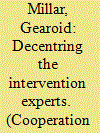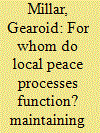|
|
|
Sort Order |
|
|
|
Items / Page
|
|
|
|
|
|
|
| Srl | Item |
| 1 |
ID:
176693


|
|
|
|
|
| Summary/Abstract |
In this paper, we develop a quantitative indicator approach including 20 indicators to measure the multiple benefits of energy efficiency (MB-EE). The MB-EEs are classified into three groups: environmental (e.g. energy savings, emissions), economic (e.g. GDP, employment), and social (health, energy poverty) aspects. We explain the methodological approach, the underlying data sources and limitations. The indicator set has been applied to 29 countries (EU28 plus Norway) for the period 2000 to 2015, proving that it allows to conduct in-depth comparisons of developments and differences across Europe. The indicator set also supports the design of well-suited energy policies by allowing to take into account, on an informed basis, more of the multiple impacts of energy efficiency.
|
|
|
|
|
|
|
|
|
|
|
|
|
|
|
|
| 2 |
ID:
159968


|
|
|
|
|
| Summary/Abstract |
The failures of peace interventions are often associated with their exogenously conceived and technocratic nature, which discount complexity within and diversity between post-conflict contexts. In response, scholars have resorted to concepts of empowerment, resistance, hybridity and friction to refocus post-conflict policymaking away from ‘top-down’ and towards ‘bottom-up’ processes. Any such efforts, however, require that policymakers understand the local drivers and everyday experiences of peace interventions across a range of cases, a task for which the current tools of the intervention experts have proven unsuited. This article, therefore, proposes an Ethnographic Peace Research (EPR) agenda that would provide access for and influence to the ‘peace kept’ and decentre the intervention experts in peacebuilding policy. In its effort to influence policy, however, an EPR agenda faces substantial challenges. These include, among others, the failure of academics to communicate clearly to non-academic audiences, the ideological biases of policymakers and the relentless simplification of complexity. However, as will be discussed and evidenced using a variety of cases below, an EPR approach also has a number of strengths that can enhance its relevance for policy, serve to decentre the intervention experts and develop a credible alternative bottom-up approach to policymaking in post-conflict states.
|
|
|
|
|
|
|
|
|
|
|
|
|
|
|
|
| 3 |
ID:
154730


|
|
|
|
|
| Summary/Abstract |
Recent peacebuilding literature provides a sustained critique of externally designed conflict management processes and promotes instead local mechanisms. Such mechanisms, it is argued, will provide more ownership and agency to local actors and, thus, a more sustainable peace. But while there are many examples of local conflict management institutions, and many discussions of the hybrid outcomes of interaction between the global and local, the literature rarely explores exactly what transpires on the ground when international actors influence the operation of local peace processes; this article provides exactly this insight. The data presented illustrate how local conflict management institutions in rural Sierra Leone are subtly manipulated by actors – both international and local – to maintain and enhance existing relations of power. The article illustrates, therefore, the problems that arise when local conflict management institutions become interlaced with new forms of power and start themselves to serve as sites of contestation and resistance.
|
|
|
|
|
|
|
|
|
|
|
|
|
|
|
|
|
|
|
|
|